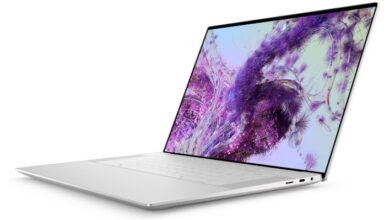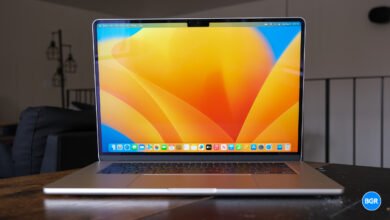Panasonic stands out as the leader in the realm of professional-grade rugged and semi-rugged PCs. Celebrating its 27th year as the top seller of laptops to the military, government, industrial sectors, police forces, and utilities, Panasonic’s reputation for excellence is well-earned—they are simply the best.
Check PricesLaunched in 2019, the Toughbook 55 (FZ-55) stands as a flagship model for Panasonic. This 14-inch laptop features three modular bays, 4G LTE connectivity, and a touchscreen that supports pen input. The latest 2024 Mk3 version, unveiled in late 2023, retains the familiar design but upgrades the hardware from Intel’s 11th Gen to the 13th Gen processors, incorporating the accompanying enhancements.
Here’s why the Toughbook 55 is still the best semi-rugged laptop on the market.
Panasonic Toughbook 55 Mk3: Price and availability

The refreshed Panasonic Toughbook 55 Mk3 is now available directly through Panasonic and associated resellers like MooringTech and GovDirect. It replaces the previous 2021 Toughbook 55 (Mk2), although all the existing accessories, mounts, chargers, and batteries are fully compatible between the two.
Prices start at approximately $2,776, varying based on the volume of purchases and configuration options. The Toughbook 55 offers a range of configurations, including different processors, optional 4G, dedicated GPS, and a choice of touch or non-touch displays. It also features RAM options from 16GB to 64GB (via 2x DIMM slots) and storage capacities of up to 2TB, with the possibility of adding a third TB through an xPak.
Special orders for security concerns can be made for Toughbook 55s with no cameras and no wireless connectivity (Wi-Fi, Bluetooth).
Panasonic Toughbook 55 Mk3: What you’ll like
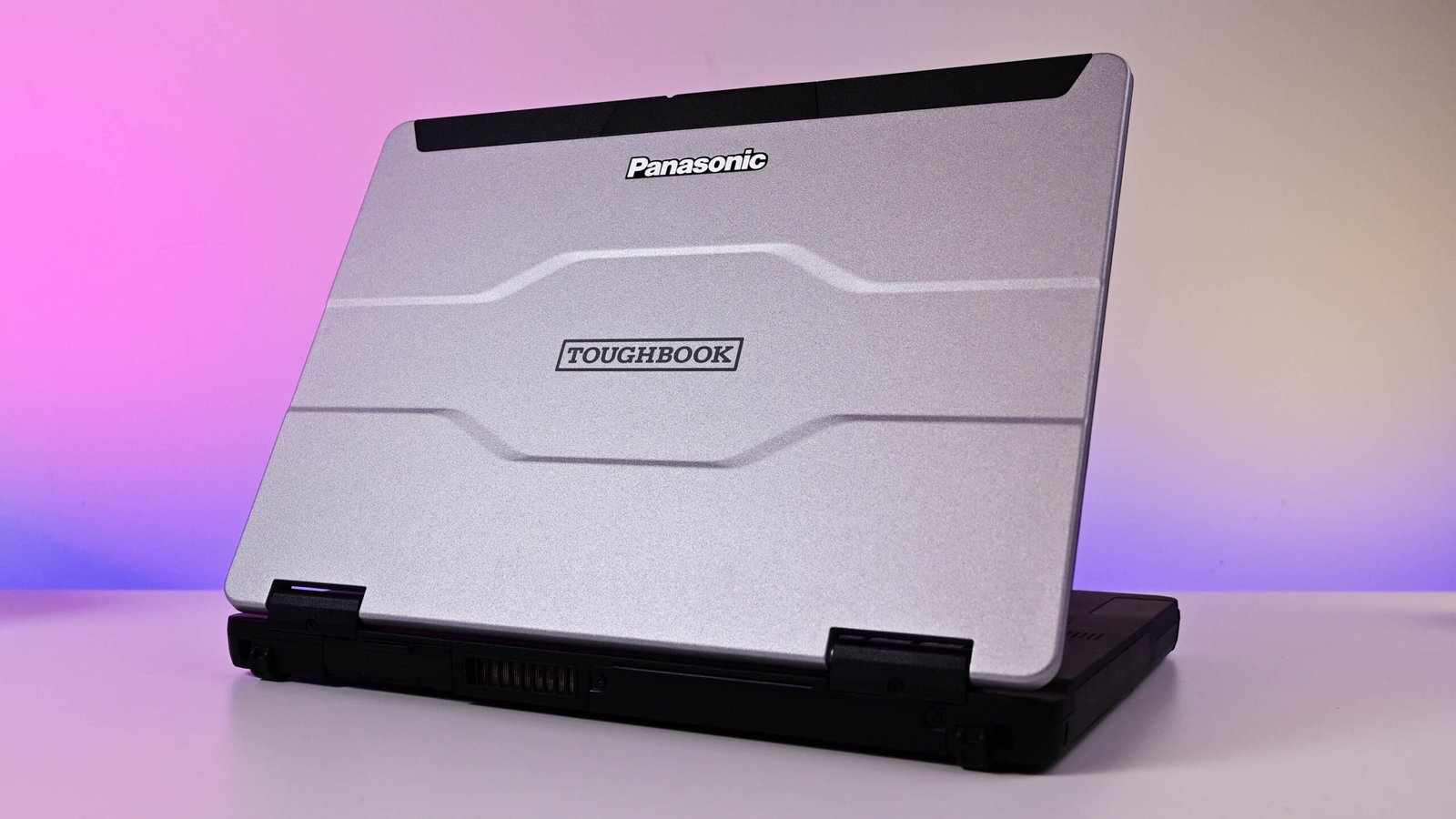
The Panasonic Toughbook 55 is classified as a semi-rugged laptop. The new Mk3 model effectively makes it an excellent consumer Ultrabook but built for professional field use. The target audience is police, fire, EMT, military, government, and utility, although anyone can buy one for personal use.
Being semi-rugged means being MIL-STD 810H compliant for short drops (3 feet), salt fog, temperature shock, etc., and being IP53 certified. IP53 means the Toughbook 55 is “dust and splash-proof,” primarily because the ports (ingresses) have covers. The keyboard is also spill-resistant, the display is recessed for impact protection, and the chassis is a rugged magnesium alloy.

While the Mk3 version is identical to the 2019 MK1 and 2021 Mk2 models externally, the hardware has been refreshed to make it faster and better than before. Indeed, the Iris Xe graphics are now so powerful Pansonic no longer needs to offer the optional AMD Radeon GPU xPak to boost graphic performance.
Here’s what’s new for 2024:
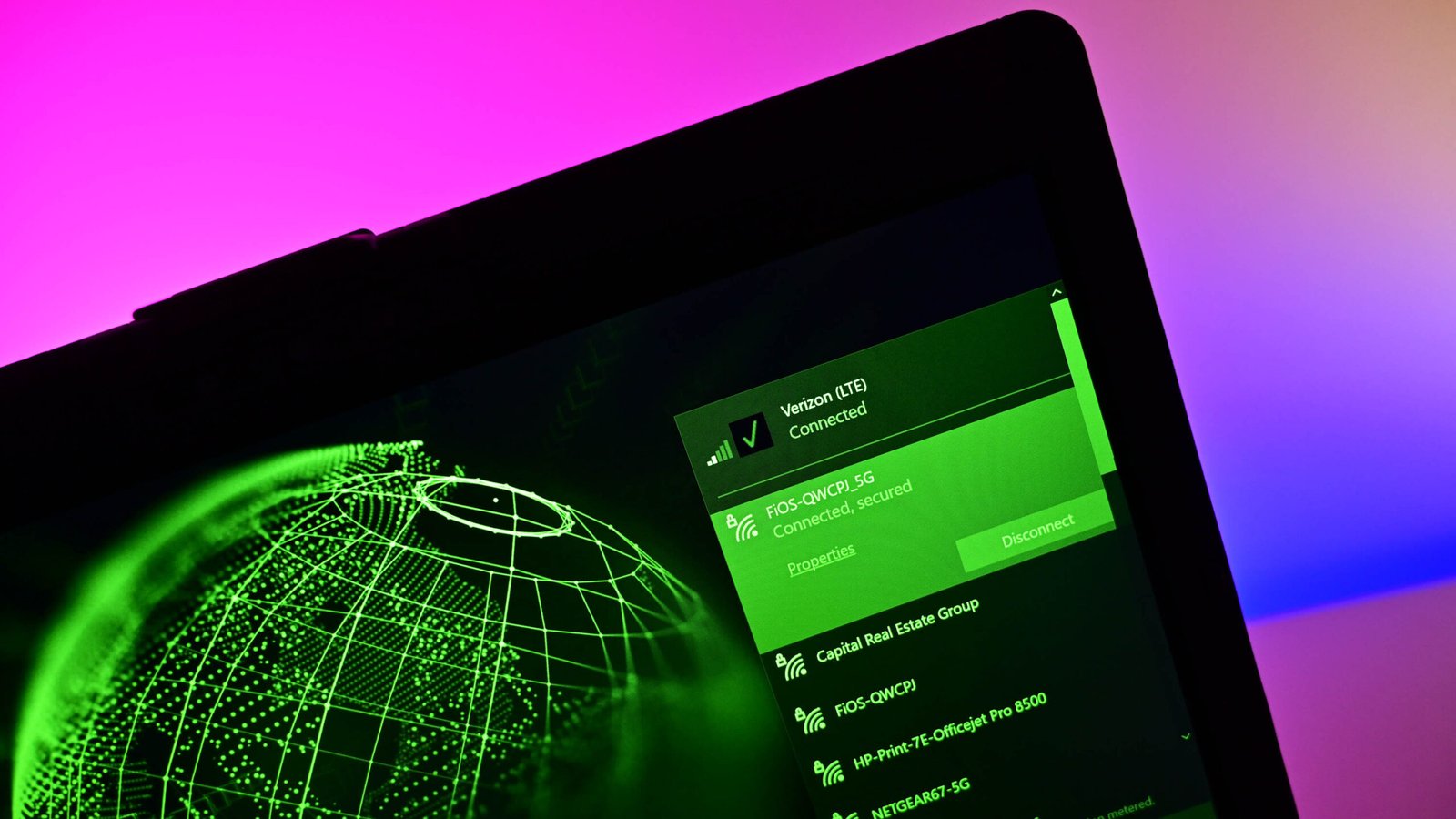
- Intel 13th Gen i5 and i7 vPro CPUs (up from 11th Gen)
- Faster Intel Iris Xe graphics
- Now up to 64GB DDR4 3200MHz RAM (vs. 32GB max)
- Now up to 3TB SSD storage (2TB internal, 1TB xPAK)
- Wi-Fi 6E (up from Wi-Fi 6)
- Bluetooth 5.3 (up from BT 5.1)
Specifications for the Toughbook 55 Mk3 will be on par with modern enterprise/business laptops in 2024. Still, it will miss out on the latest Intel Metor Lake with Core Ultra processors in premium consumer laptops, including a discrete NPU for forthcoming AI tasks.
Swipe to scroll horizontally
| CATEGORY | PANASONIC TOUGHBOOK 55 MK3 |
|---|---|
| Operating system | Windows 11 Pro |
| Display | 14-inch, 16:9, IPSHD (1366×768) Non-touch |
| Row 2 – Cell 0 | Full HD (1920×1080) TouchAnti-reflective and anti-glareDay/Night ModeUp to 1,000 nits |
| Processor | Intel Core i5-1345U vPro (4.7GHz) |
| Row 4 – Cell 0 | Intel Core i7-1370P vPro (5.2GHz) |
| Graphics | Intel Iris Xe |
| Memory | Up to 64GB DDR4 3200 (2 DIMMs) |
| Storage | 512GB, 1TB, or 2TB Quick-release OPAL NVMe SSD with heater |
| More storage | Up to 1TB OPAL NVMe with heater via xPAK expansion |
| Front camera | 1080p with privacy shutter Tetra-array mic |
| Security | Infrared with Windows Hello Secured-core PC TPM 2.0 NEST BIOS compliant Kensington cable lock (x2) Optional SmartCard reader (xPAK) Optional contactless SmartCard reader (xPAK) Optional fingerprint reader (xPAK) |
| Connectivity | Wi-Fi 6eBluetooth 5.3Optional 4G LTE-A (FirstNet)Dual-SIM (Nano, eSIM)CBRS Band 48 compatibleOptional dedicated GPS (u-blox NEO M8N) |
| Ports | USB-C Thunderbolt 4, USB-A x2 (10Gbps, 5Gbps), MicroSDXC-UHS-1, HDMI 2.0, Ethernet RJ-45 |
| Row 13 – Cell 0 | Optional: USB-A, Fischer USB, VGA, 2nd Ethernet, Serial D-sub 9-pin |
| Audio | 92db speakers (top deck) |
| Battery | 6300mAh (optional x2) Up to 19 (38 hours x2) Hot swap with optional 2nd battery |
| Water resistance | IP53 MIL-STD 810H |
| Dimensions | 10.7 x 13.6 x 1.3 inches |
| Weight | 4.6 pounds (HD model), 4.9 pounds (Touch FHD model) |
Thanks to the Intel 13th-generation processors and Iris Xe graphics, the Toughbook 55 does well in our benchmarks, pulling ahead of the HP ZBook Firefly 14 (G10), which is a powerful workstation.
Panasonic’s thermal solutions are pretty basic compared to prosumer laptops. Hence, performance is not at the top, but it is markedly improved from the previous Mk2 model with 11th-generation Intel as its PCMark 10 score jumps from 4,819 to 6,074, where it pulls ahead of the ASUS ZenBook 14 OLED (UM3402) with its AMD Ryzen R7 7730U processor.
Reviewed configuration
• Price: $4,138 At Panasonic
• Display: 14″ Full HD 1980×1080 touch/AR
• CPU: Intel Core i7-1370P
• GPU: Iris Xe
• RAM: 32GB
• Storage: 512GB
• Cellular: 4G LTE
There is a significant difference between the Mk2 and Mk3 models in terms of everyday real-world performance, and it’s not just about some numbers on a benchmark. The 13th Generation Core i7-1370P has 14 cores compared to the Core i7-1185G7’s mere four, and it also boasts a Peak Turbo frequency of 5.2GHz, which is an improvement from the 4.8GHz of the Mk2.
Due to Intel’s P- and E-core configuration, more cores mean better efficiency, lower temperatures (less fan usage), and better background performance for system-level tasks.
Battery life is outstanding. With both battery packs enabled, the Toughbook 55 easily goes past 20 hours of usage and can likely go past 25 hours, especially when left in night mode. This laptop could last for days since the battery packs can be hot-swapped. Toss in a 100W or 120W solar charger; you could use this laptop indefinitely in the field.
Panasonic is unmatched in this field, and the Toughbook 55 shows why.
The Toughbook 55 Mk3 boasts a 14-inch IPS display that greets you as soon as you open it. The Full HD (1920×1080) touchscreen of the review unit is glove-friendly and comes equipped with a stylus that can be stored in a dedicated compartment. You have the option of choosing from four touch modes, including inking only, touch and inking, or touch with gloves.
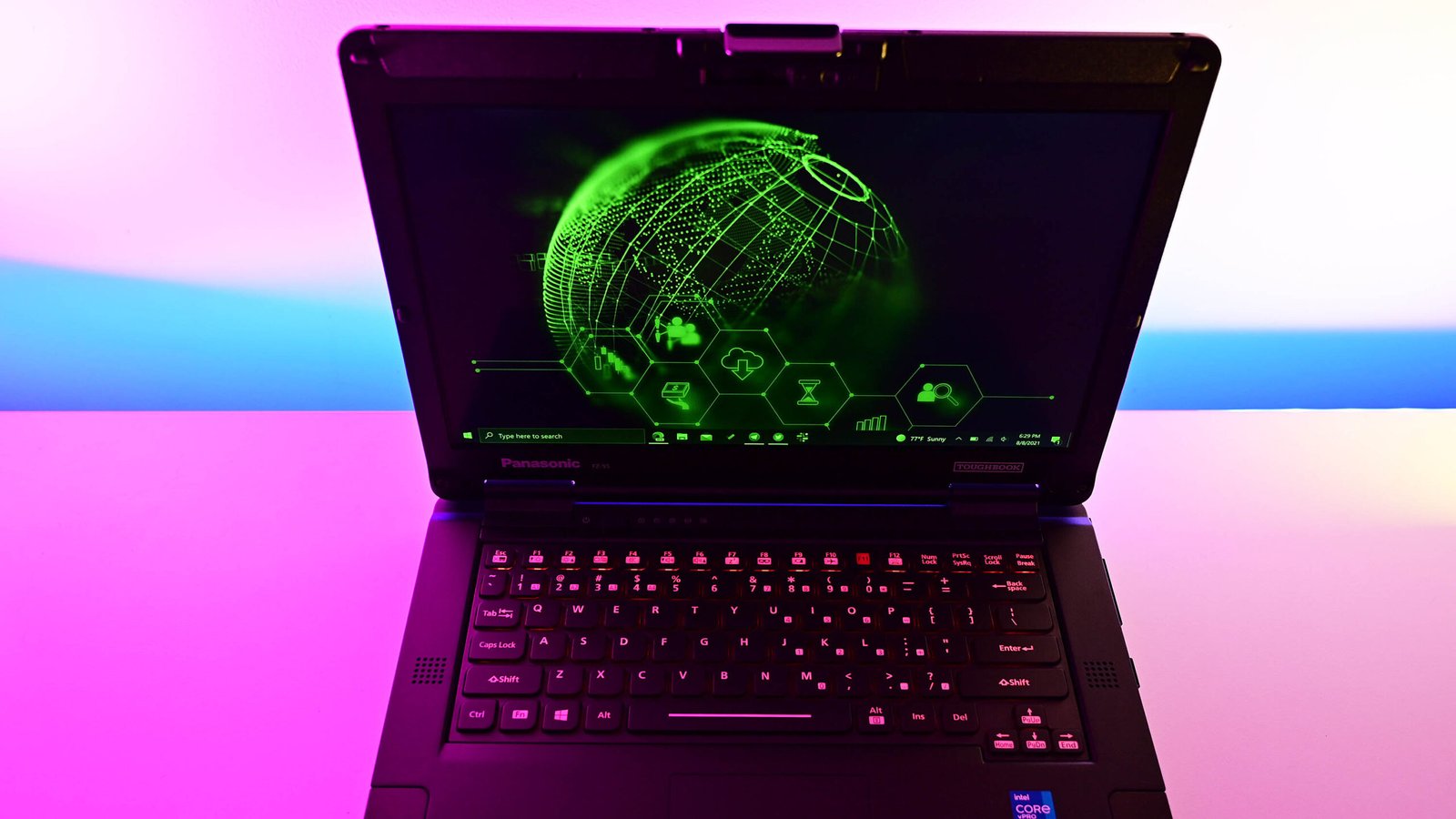
While not a color-accurate display (63% sRGB, 47% DCI-P3), the Toughbook 55 Mk3 is not aimed at graphics professionals or those who do professional media editing. The screen is uncalibrated, which is not unexpected. However, it does hit an unusual 912 nits of peak brightness (just shy of the claimed 1,000 nits), which, combined with the matte and anti-reflective properties, makes it very viewable outdoors (there is also a sensor to auto-adjust brightness).
Like other Toughbooks, the Toughbook 55 Mk3 has a day/night mode. In this mode, users can set the display to orange, green, red, blue reduced, or grayscale. Likewise, the keyboard backlight can be set to white, red, blue, or green.
The screen can also drop down to just 0.5 nits of brightness (the lowest I have ever seen), which makes this laptop excellent for night work or while wearing night goggles.
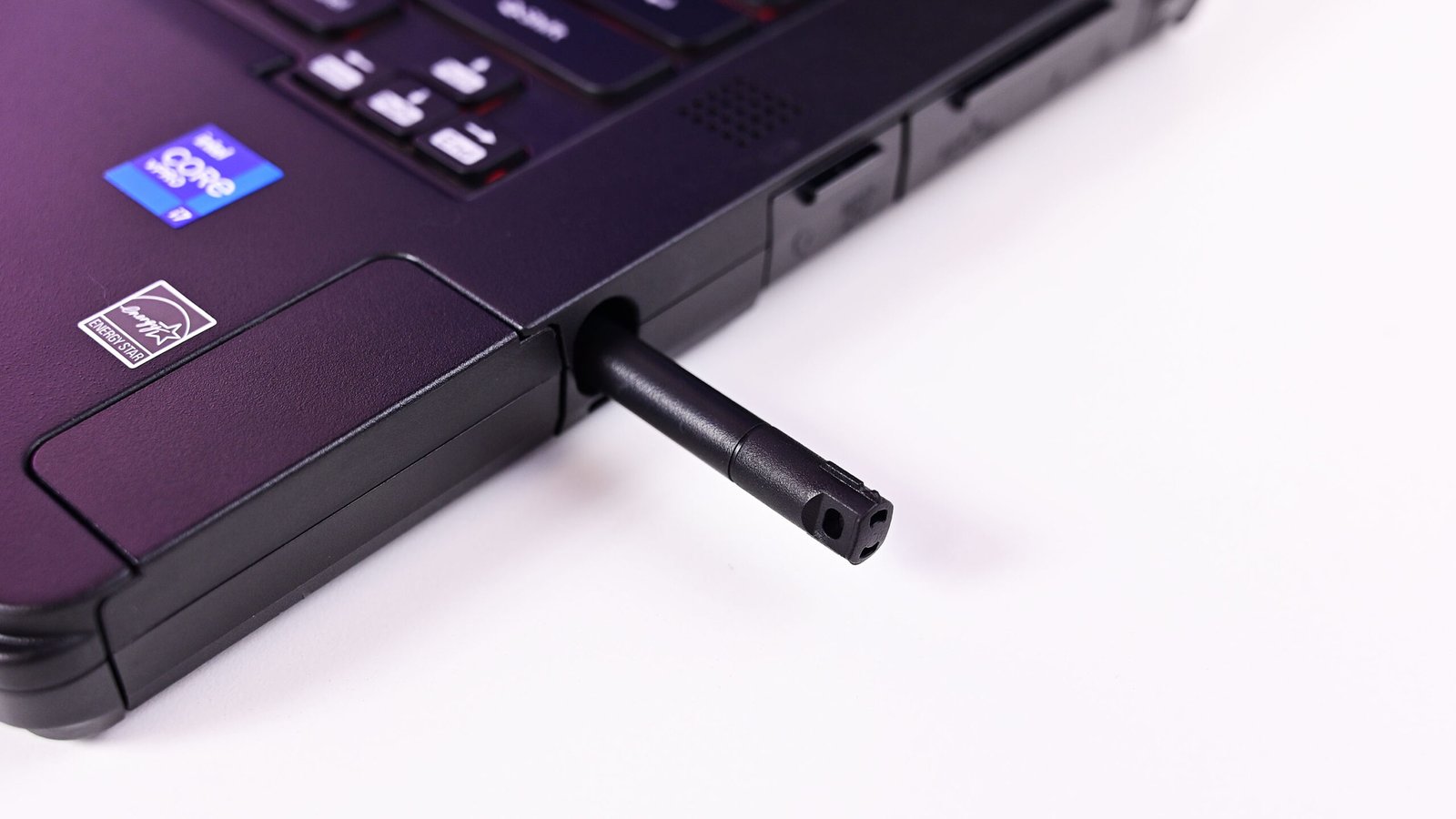
The spill-resistant keyboard is replaceable and very enjoyable to type on even compared to prosumer laptops. The keys are spread out enough that you can type while wearing gloves.
Unlike other Toughbook PCs, this one uses Microsoft Precision drivers. While it is still a small trackpad, the drivers and buttons make it very functional, and I have no complaints.

The device has two top-firing speakers that can reach a maximum volume of 92dB, which is extremely loud. However, these speakers are not suitable for watching movies as they lack depth, bass, and presence. They are designed for outdoor and noisy environments, making them perfect for hearing voices.
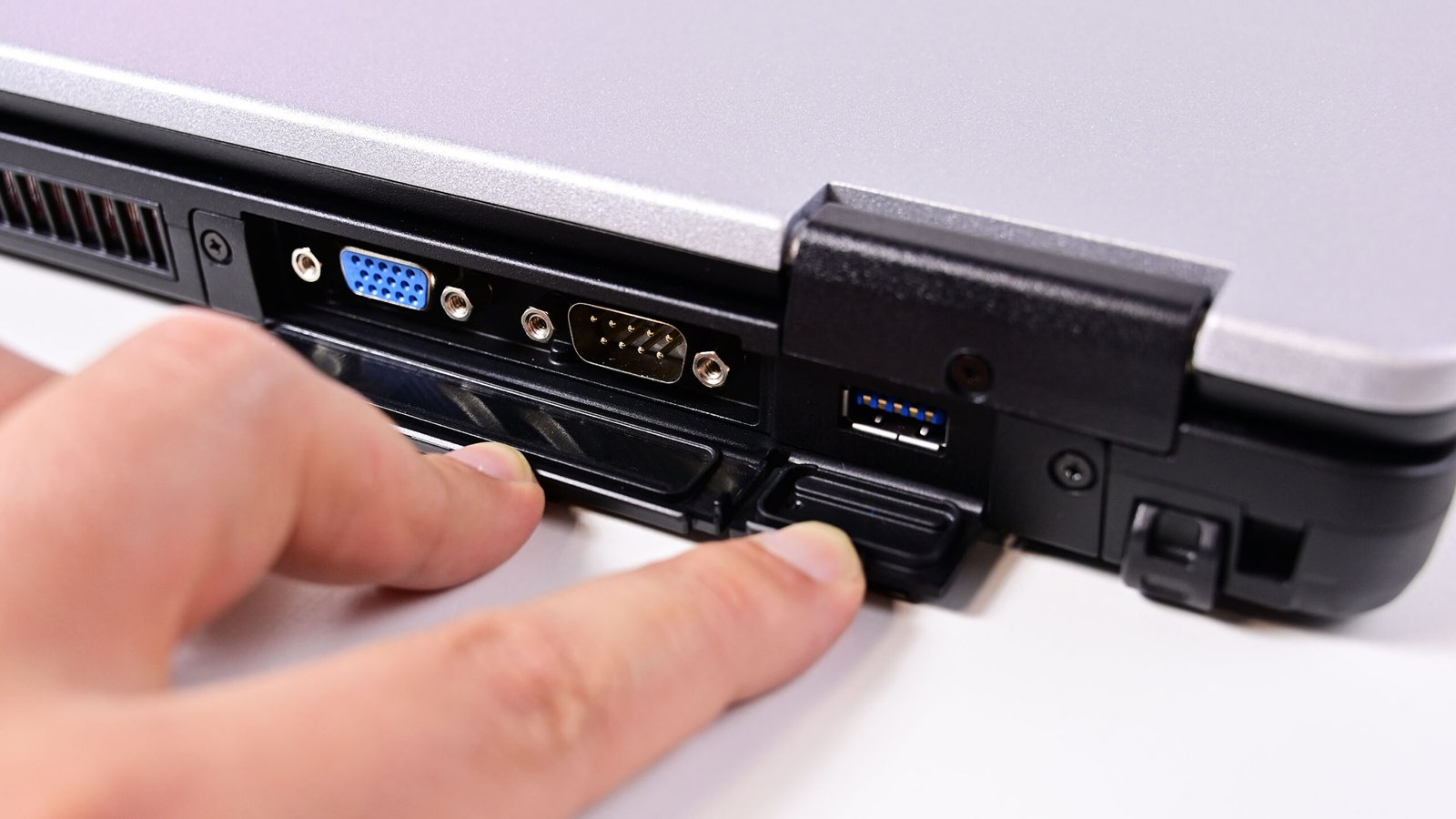
The front-facing full HD camera is quite decent, and the four front-facing microphones ensure excellent communication in the field. A sliding privacy door hides the camera and the Windows Hello infrared sensor.
The real magic of the Toughbook 55 is its three modular bays. By default, the laptop has one battery pack, and the other two bays have empty fillers. Customers can purchase various xPAKs to adapt the computer for multiple missions without returning the laptop to Panasonic for servicing. Two bays are toolless (the rear has some simple screws), and customers can add more ports via the rear expansion area.
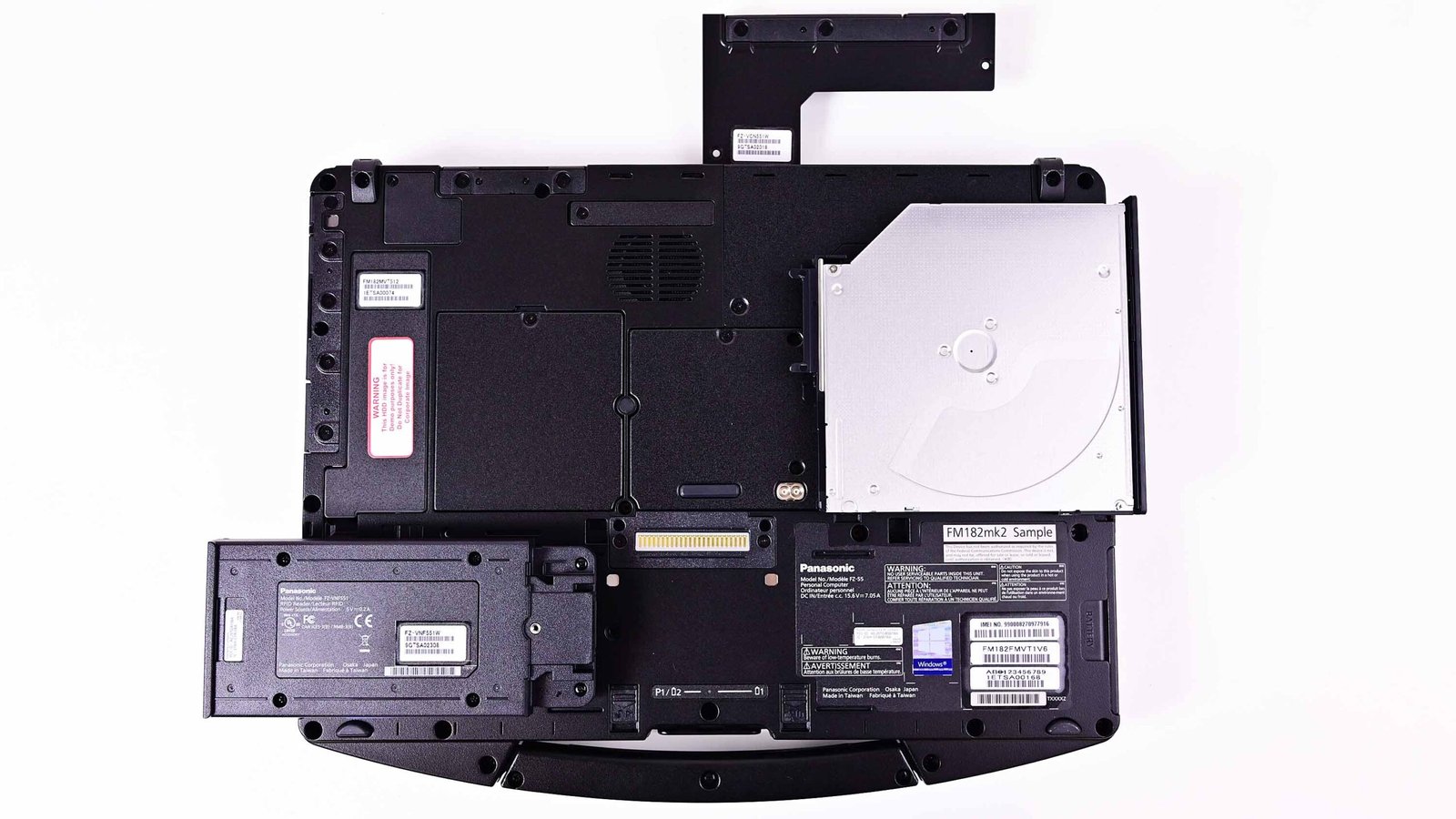
The various xPAKs include:
- “The rear expansion area includes VGA and Serial ports, along with one of the following options: USB-A, LAN, or Fischer USB.”
- The front expansion area of this device supports three different types of security features: a fingerprint reader, a contactless smartcard reader, and an insertable smartcard reader.
- Expansion area includes Barcode reader, Smartcard slot, Blu-ray and DVD drives, 2nd OPAL SSD, USB-C and USB-A.
On the earlier Toughbook 55 from 2019 (Mk1), an optional AMD Radeon WX4150 GPU xPAK was offered to improve over the Intel UHD graphics. That GPU no longer works with the Mk2 or Mk3 versions, but the new Intel 13th Gen Iris Xe integrated GPU now significantly beats that discrete AMD GPU, making it irrelevant.

Optional 4G LTE with multi-carrier support and satellite GPS lets this laptop connect anywhere in the world. Customers can drop in a SIM (in the rear) or use an electronic SIM (eSIM). Customers can also order a dedicated GPS module (u-blox NEO-M8N) and use built-in Band 48 CBRS (private LTE).
Panasonic Toughbook 55 Mk3: What you won’t like.
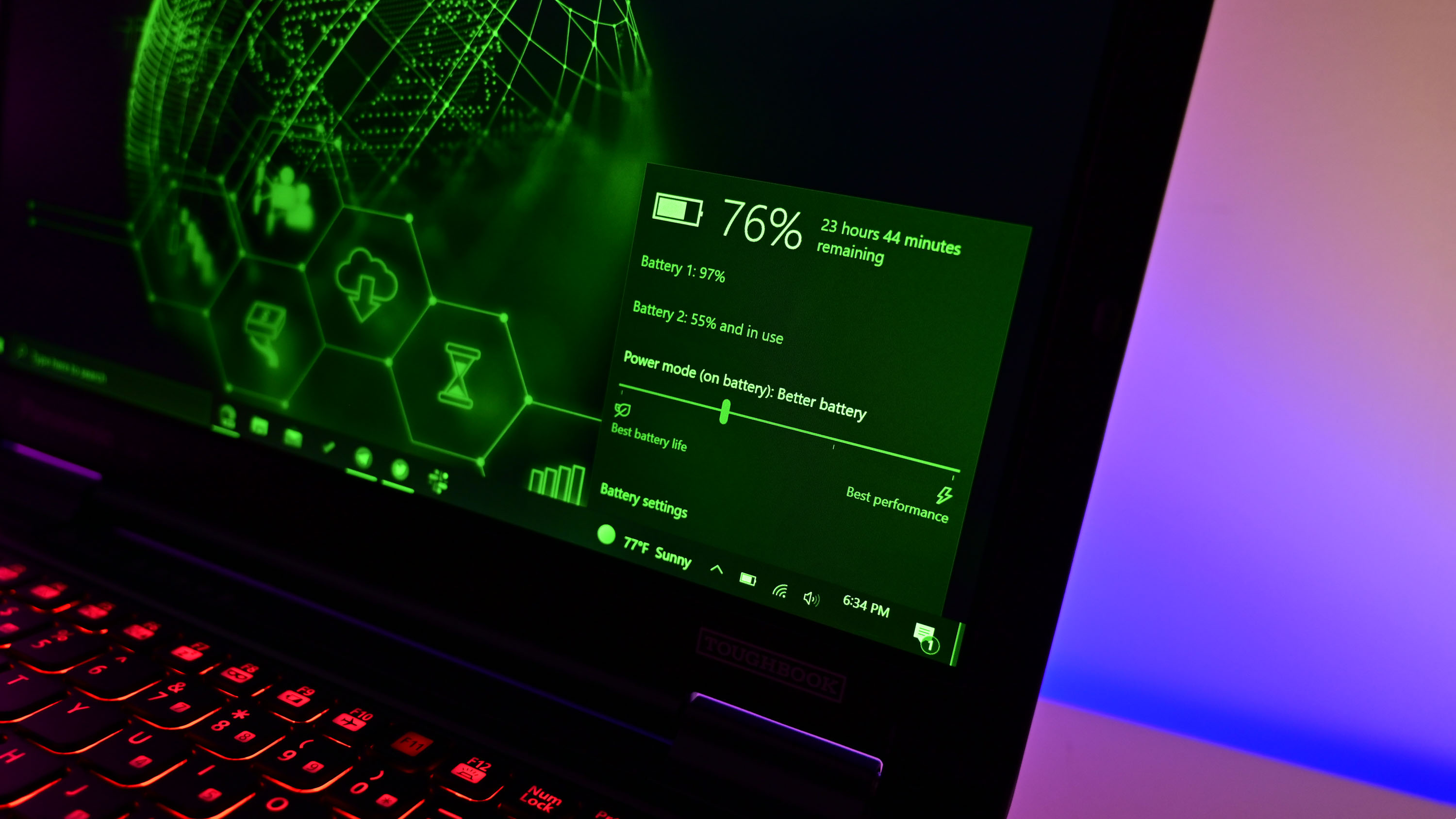
The Toughbook 55 has no significant shortcomings. The Mk3 model introduces modern features such as Thunderbolt 4 and a substantial performance increase. Typically, laptops designed for enterprise and field use are behind the consumer market. Yet Panasonic keeps close pace despite a launch cycle that doesn’t exactly match the consumer market. Businesses generally don’t concern themselves with this aspect. Panasonic conducts extensive testing on these laptops, including software reliability, which delays their market release compared to consumer models.
Furthermore, enterprises prioritize the availability of Intel vPro, which often follows the non-vPro versions. For example, Intel recently unveiled the Intel Core Ultra with vPro, which is not expected to ship for several more weeks. In contrast, Panasonic has been offering the Mk3 i7 vPro model since late 2023 and the vPro Core i5 model since February, aligning with their customers’ current needs.
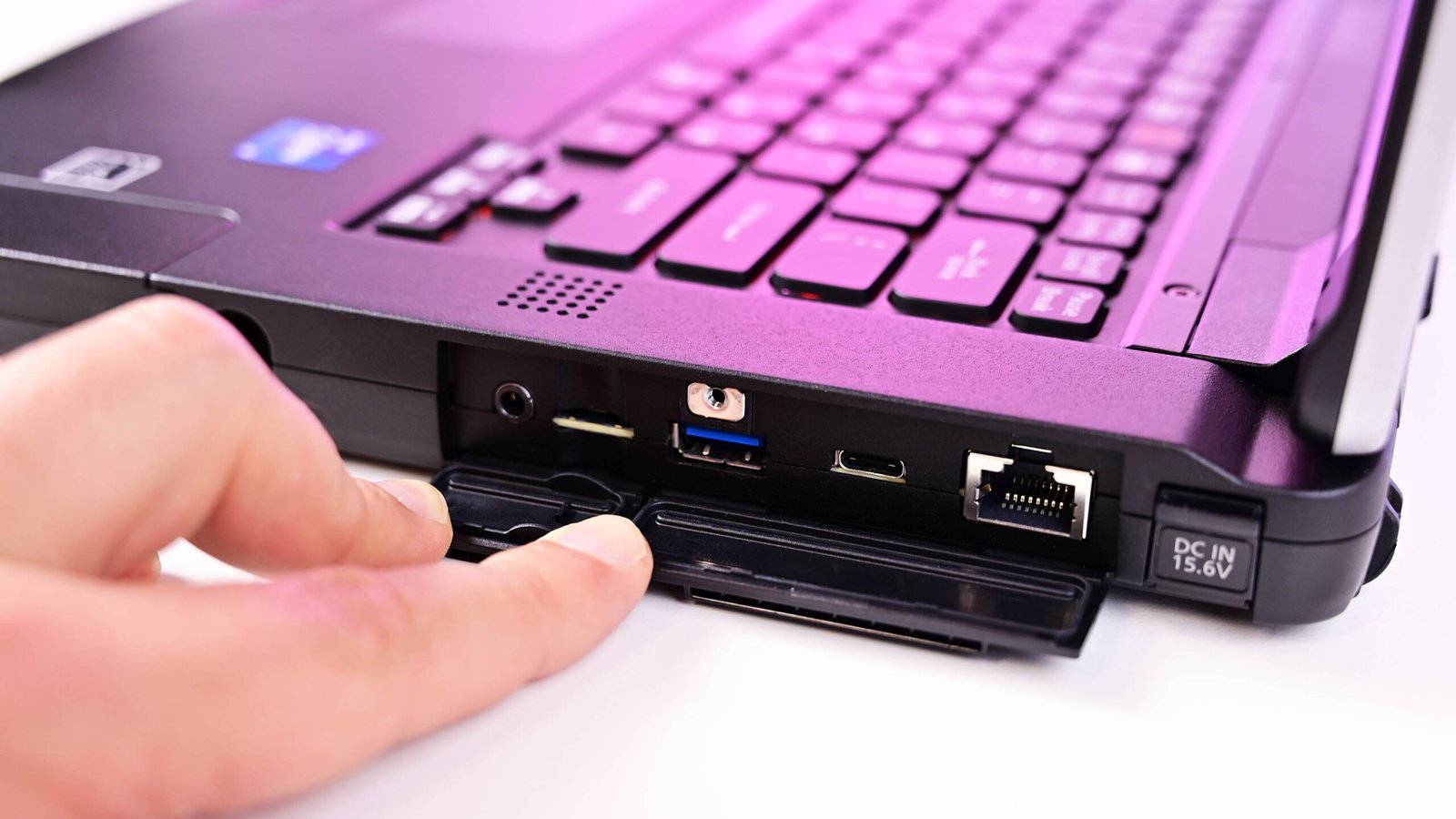
The only suggested improvement is the addition of an optional 5G modem. However, the target audience for this laptop currently shows less interest in 5G, making this a minor point. Panasonic has informed me that it collaborates closely with its customers to prioritize features, and for them, 5G is not as essential as 4G LTE. Moreover, the complexity of 5G antenna systems means that integrating 5G would require a significant redesign of the Toughbook 55, as it’s not as simple as inserting a 5G modem.
Additionally, the use of a haptic touchpad could make the Toughbook 55 even tougher due to the lack of moving parts found in a traditional touchpad. And since this physical touchpad doesn’t depress (“click”) to ensure reliability, a haptic touchpad is precisely designed to simulate such a function, making it ideal for this laptop.
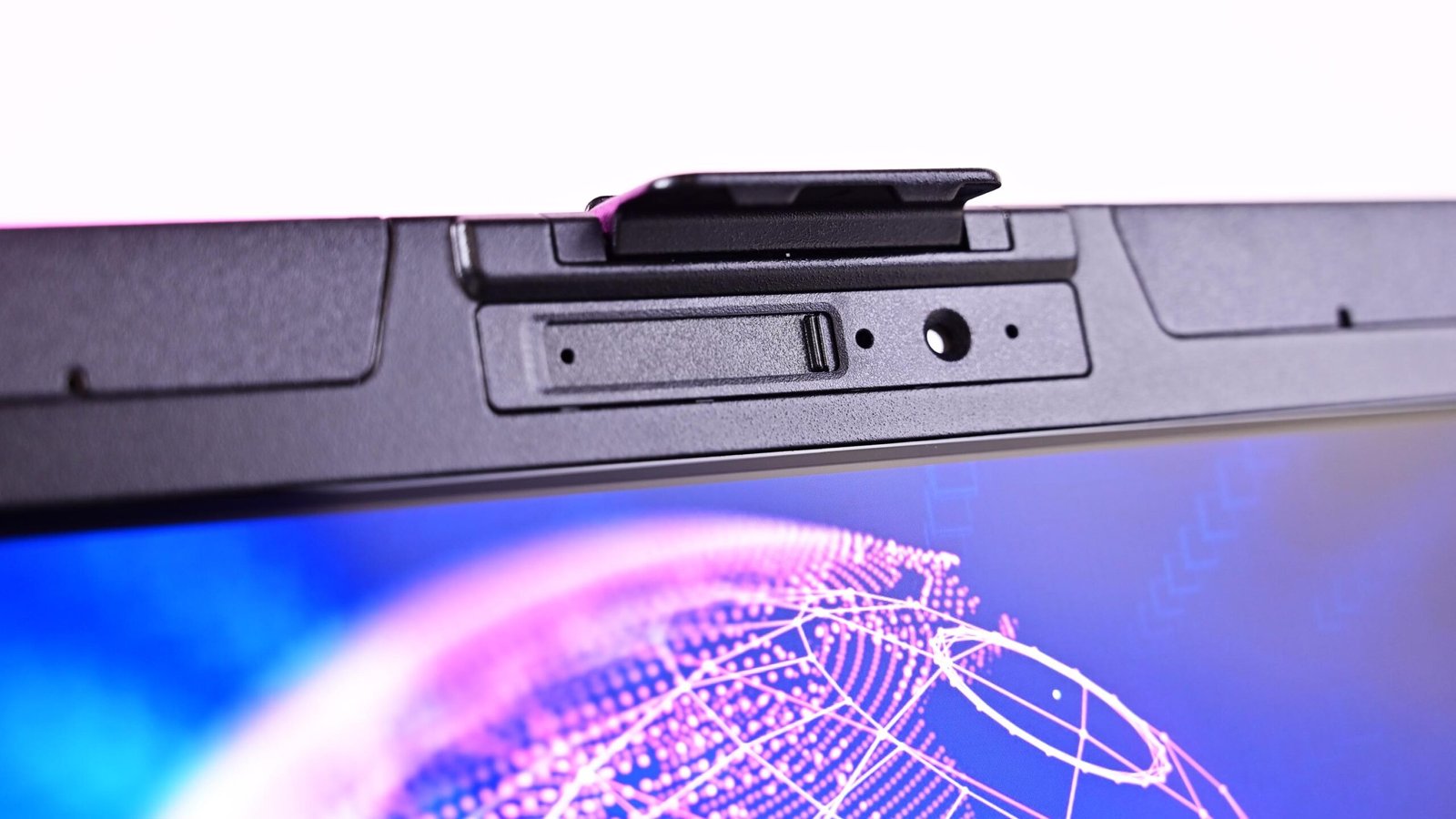
Switching to a taller 16:10 display instead of the usual 16:9 could result in less scrolling and more efficient information display, which is always beneficial. Although I wouldn’t mind having a 2K resolution, Panasonic values affordability, battery life, and practicality over consumer preferences.
Panasonic Toughbook 55 Mk3: Competition

There aren’t many competitors for the Toughbook 55 laptop, mainly because other companies such as Dell have not updated their rugged PCs. While the Dell Latitude 5420 has a 14-inch screen and a similar design to the Toughbook 55, it is still running on Intel’s older 8th Gen CPU. The Dell laptop lacks modularity, except for a hot-swappable battery, doesn’t have Thunderbolt 4, uses Bluetooth 4.2/Wi-Fi 5, is slightly heavier, has only 16GB of RAM, and doesn’t offer 4G LTE as an option. It feels like Dell is phasing out rugged devices due to Panasonic’s strong presence.
The Toughbook 55 is easily the best semi-rugged laptop right now and likely for the next few years.
There is the Dell Latitude 5420 with a 14-inch display, which is very similar in overall design and audience to the Toughbook 55. However, it is still on Intel’s older 8th Gen CPU. It has no modularity besides a hot-swappable battery, no Thunderbolt 4, uses Bluetooth 4.2/Wi-Fi 5, is slightly heavier, has just 16GB of RAM, and has no option for 4G LTE. It also feels like Dell is slowly backing out of rugged devices due to Panasonic’s strong presence.
Other options start to veer to different form factors. Panasonic offers the Toughbook 33, a 2-in-1 tablet PC with a keyboard. There is also the 10.1-inch and brand-new Toughbook G2, which is also very modular.
We have more recommendations in our best rugged laptops guide.
Panasonic Toughbook 55 Mk3: Should you buy it?
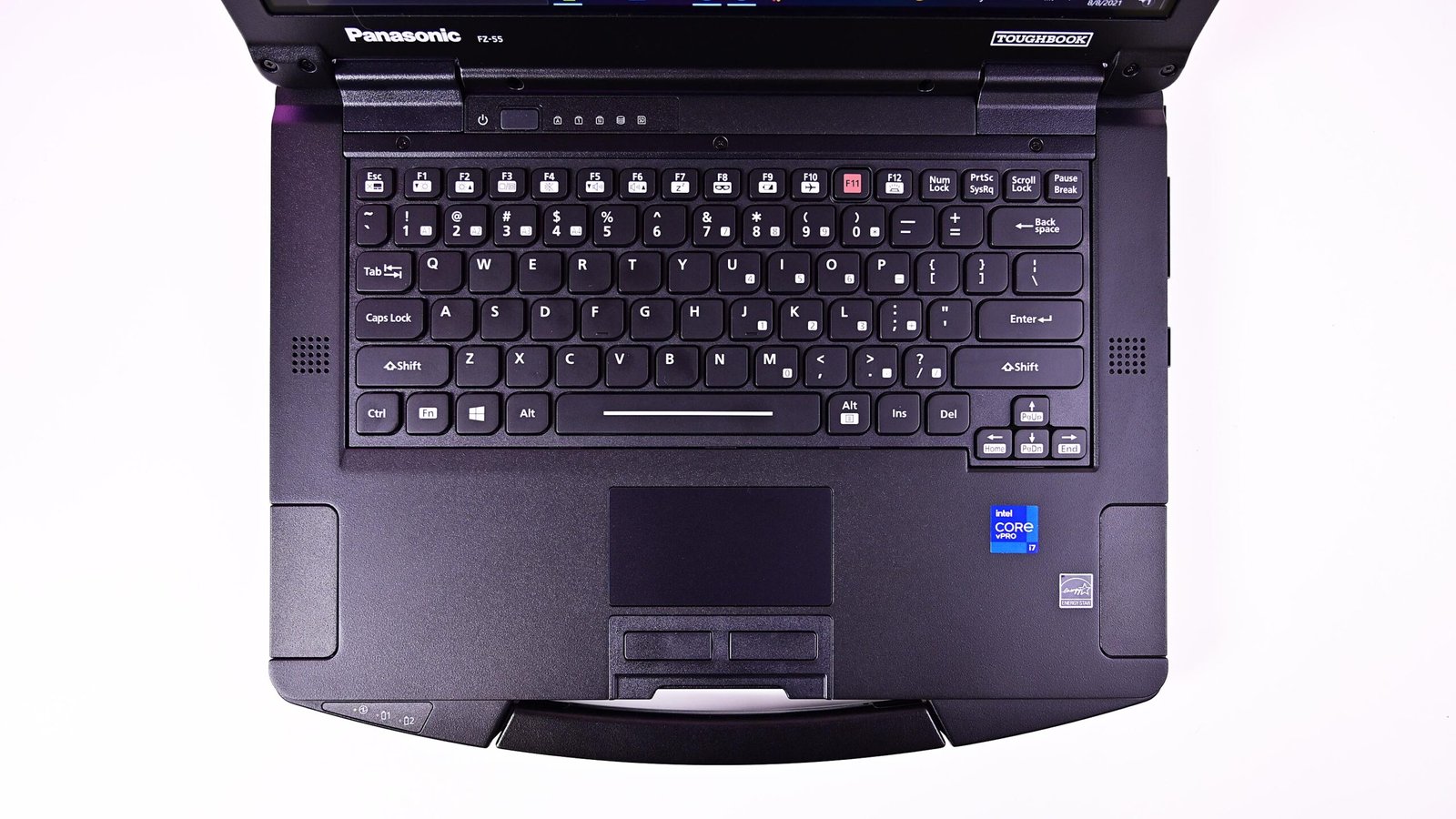
You shouldn’t buy this if …
Although I am not the target audience for the Toughbook 55, it is still one of my favorite laptops, which speaks volumes about its quality. With a battery life of up to 25 hours, constant internet connectivity, an integrated handle, and its ruggedness, this laptop is incredibly enjoyable to use. This indicates that the Toughbook 55 is an exceptional device. If someone like me, who is picky about laptops, finds it attractive, then emergency medical technicians, police officers, or military personnel would likely appreciate its speed, reliability, and all the modern features of a 2023 prosumer laptop.
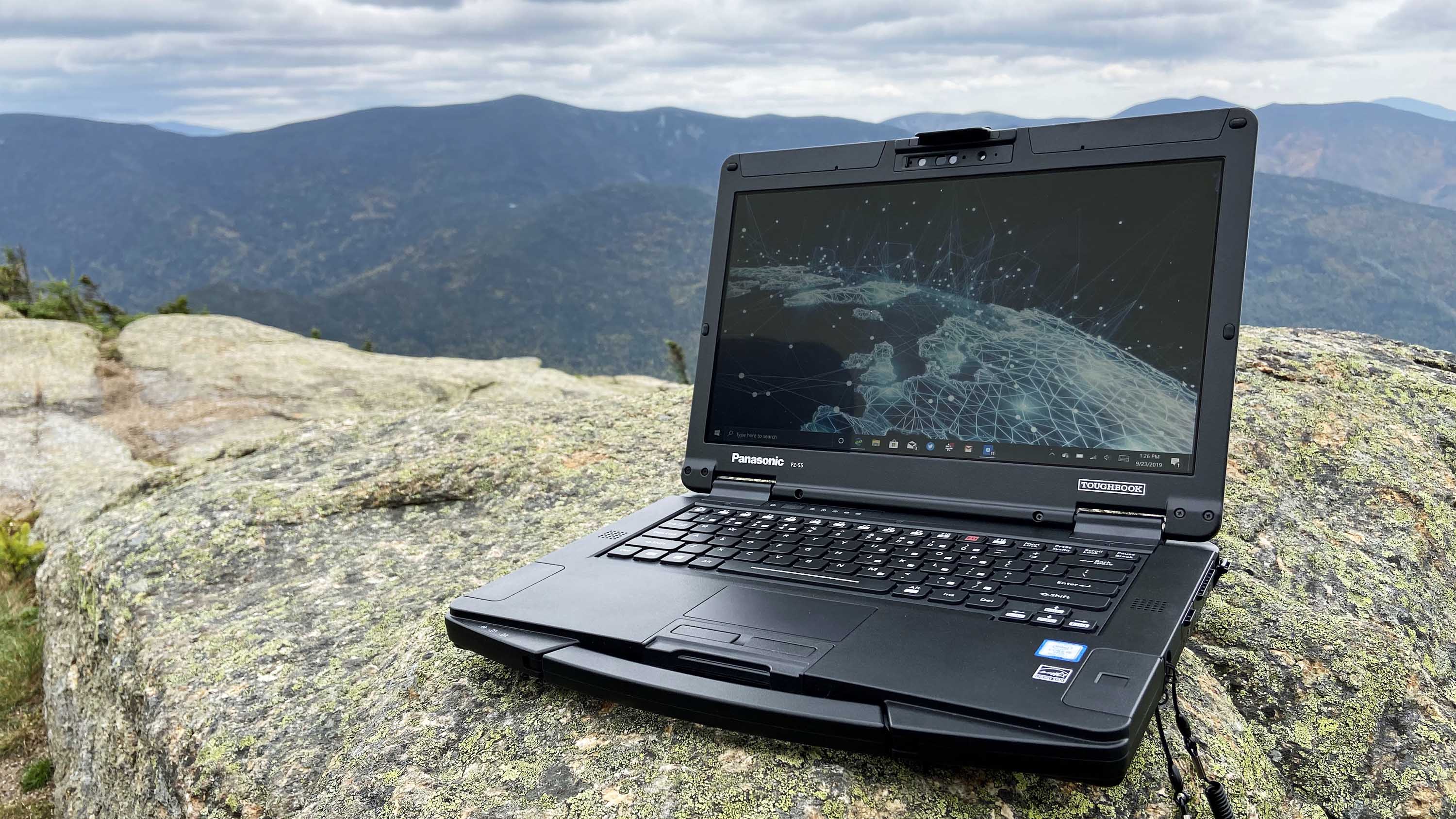
Panasonic is almost unmatched in this field, and the Toughbook 55 shows why. Its rugged and semi-rugged PCs (and Android tablets) have not just the best features and designs but the best features and designs its core customers want. Panasonic then executes those requirements with outstanding engineering.
Equipped with a 13th-generation Intel processor, built-in 4G LTE, and on-the-fly customization capabilities, the Toughbook 55 stands out as the premier semi-rugged laptop currently available and is expected to remain at the forefront for the coming years.

Panasonic Toughbook 55 Mk3
The Panasonic Toughbook 55 has received a major upgrade in 2024. It now features the latest Intel 13th Gen processor, significantly improved Iris Xe graphics, Wi-Fi 6E, Bluetooth 5.3, and enhanced RAM and storage capacities. With these upgrades, the Toughbook 55 has solidified its position as the premier semi-rugged computer for professionals.

